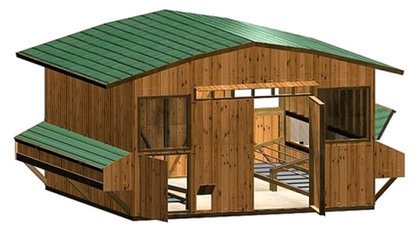8 Step Guide to Baby Chicks
Baby chicks are available most any time of year. You can find them on line, from breeders in your area and at most feed store chains in the spring.
If you find yourself at the feed store about to buy chicks you should also find most everything you need to raise them. There are three immediate needs for these young chickens to survive in your care: HEAT, FOOD, & WATER.
Guide to Baby Chicks Step 1
HEAT: You can purchase a ready-made brooder for your chicks or make your own. The simplest brooder can be made of a sturdy card board box 12+ inches tall, lined with newspaper topped with a good layer of wood shavings or straw, and a heat lamp hanging in the middle or safely clipped to the side.
Plastic storage boxes with ventilation added make great brooders as well.
A thermometer at the floor level of the brooder should provide baby chicks the following readings:
1st Week 90 – 95F
2nd Week 85 - 90
3rd Week 80 - 85
4th Week 75 - 80
5th Week 70 - 75
6th Week +70
As baby chicks mature, the fluffy down they hatch with will be replaced with hard feathers and more down that are able to hold heat to their bodies. Newly hatched chicks are unable to maintain body heat without a mother hen or form of electric heat.
Guide to Baby Chicks Step 2
FOOD: Prepared Chick Start is a perfect food and available at most feed stores. It must be available to chicks 24 hours a day. Some Chick Start has an antibiotic mixed in and should NOT be fed to healthy chicks.
There is no need to measure feed for chicks. They should eat as much and as often as they want. Too little food will slow their development and cause the more dominant nature chicks to bully the less dominant, which can lead to illness and death.
Guide to Baby Chicks Step 3
WATER: Clean water must always be available to baby chicks. They will be unable to digest feed if their water supply spills or runs dry.
NEVER place open dishes of water in the brooder. Chicks can’t swim and will most certainly kick floor litter and droppings into it.
A common chick water container is an inverted mason jar with a screw-on cap that allows water to flow to replace what is used from the trough ring. Placing the water source slightly above floor level and raising it as the chicks grow will help keep the supply cleaner.
Guide to Baby Chicks Step 4
ROOM TO EXERCISE AND GROW: As baby chicks grow, they need more food, water and room to move around. Some natural sunlight is important, too.
Standard sized baby chicks will need the following approximate area in the brooder. Giant breeds, will of course need more and fast growing Cornish Cross, nearing adult size at 6 weeks need much more.
Below is an estimate of area needed:
Guide to Baby Chicks Step 5
HEALTHY HAPPY CHICKS: The better you can mimic a natural environment for any age of chicken, the happier and healthier they will be. In spite of 8000 years of domestication chickens all over the world thrive when provided a good and plentiful balanced diet, fresh air and sunshine, and enough room to explore and move away from the flock while still enjoying the security of their presence.
Baby chicks are no different. Any caged animal can become bored if there isn’t some form of enrichment like things to climb on and new healthy foods to taste.
A chicken’s naturally curious nature can take on a destructive nature against flock mates in an environment void of choices. Lack of space and things to do can lead to dominant nature chicks preying on the less dominant, pulling feathers, creating wounds, even killing and cannibalizing the least hearty flock members.
For this reason, mixing different ages of chicks, in a confined area, is a poor choice. The larger and more mature chicks will often bully the smaller and less mature.
If you notice some baby chicks displaying an overpowering dominant nature towards others, creating a separate brooder for them will be very helpful.
Unless sick or injured, placing a single chick in its own brooder can cause undue stress, since chickens are flock animals.
Guide to Baby Chicks Step 6
THINGS TO WATCH FOR: One of the most common disorders in chicks can be diarrhea. Droppings may stick to feathers around the vent and if not cleaned off can block the vent and prevent new droppings from exiting.
This is a life threatening situation. Gently removing the build-up and applying a bit of petroleum jelly will help prevent new build up on baby chicks.
You may need a bit of soap and warm water to soften a clump of dried droppings to avoid tearing skin or ripping out feathers when removing it.
If extremely hard, use a pair of needle nose pliers, (MAKING SURE NOT TO PINCH THE CHICK) to crack the clump. You may find a condition similar to diaper rash under the dried feces, and possibly some swelling or bleeding of the vent. If a baby chicks vent was completely blocked be prepared for a sudden gush of droppings.
Wash and dry the area, apply a little petroleum jelly and make sure other chicks aren’t pecking at the vent of this chick. If they are, or if it seems weak, remove that chick for a day or so, to a private brooder and allow it to recover.
To treat diarrhea I suggest some live culture plain yogurt or probiotics, as a first step. You may need to use Medicated Chick Start. Introducing chicks to chopped greens or clean tender grass clippings can help with better digestion.
Providing small grit or sand may help also. Medicated Chick Start can cause diarrhea by killing good digestive bacteria if used unnecessarily.
Guide to Baby Chicks Step 7
PROTECT BABY CHICKS: Your chicks living in a brooder and eventually out to a pen, probably don’t have a mother hen to protect them, so you must provide protection.
These little ones can fall easy prey to domestic pets and wild critters. Cats, dogs, rats, snakes, opossums skunks, weasels, raccoons, and birds of prey find young chickens an easy and tasty meal, if they can get to them.
Brooders should be out of reach of rodents and larger animals. When chicks are moved to a pen, the size of the wire should keep them in and others, even larger chicks or chickens, out.
Guide to Baby Chicks Step 8
FINAL THOUGHTS: The transition from warm brooder to pen is a big one for baby chicks or young chickens. Waiting for the right day and a warm enough night to move young chickens outside is unrealistic.
The simplest thing to do is continue to provide a heat lamp day and night. By the time you move them to a pen, most chicken breeds will have the strength and feathering to fly up to a roost, as their nature tells them each night.
Make sure it’s low enough for their ability. A heat lamp hanging above the roost will encourage them to get up there and spend the night. Just make sure all can get up and no one chick is left alone in the cool of the night on the floor.
Some breeds of chicks are unable to roost well like heavy Cornish Cross and some of the fuzzy breeds lacking hard flight feathers, like Frizzle Cochins and Silkies, so heat near the floor may be necessary.
When you need a new coop...
I often get questions about building chicken coops. In order to best help you in this area I took the time to preview a couple coop plan resources.
I encourage you to click here and discover my findings.
If you're looking for a quality set of chicken coop plans then take a look as I narrow it all down. I know everyone brags about their plans so I wanted to help simplify the process for you.
Or, just click the image below to read the review...
Return From Guide to Baby Chicks to All About Chickens

Custom Search





New! Comments
Have your say about what you just read! Leave me a comment in the box below.